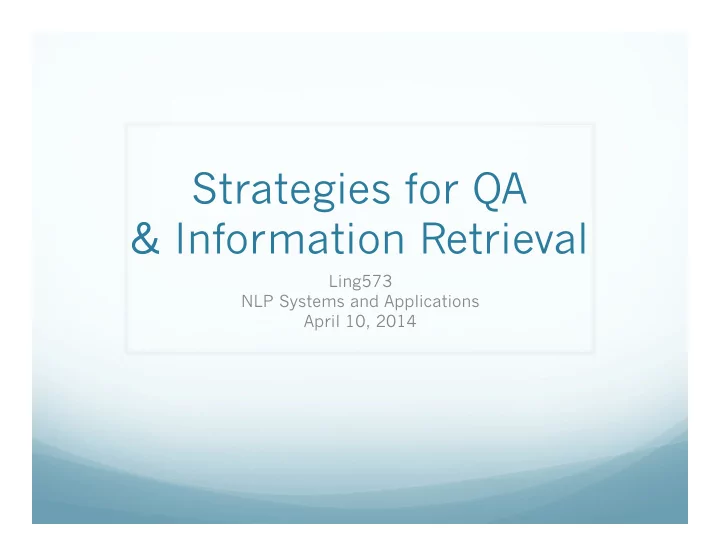

Strategies for QA & Information Retrieval Ling573 NLP Systems and Applications April 10, 2014
Roadmap Shallow and Deep processing for Q/A AskMSR, ARANEA: Shallow processing Q/A Wrap-up PowerAnswer-2: Deep processing Q/A Information Retrieval: Problem: Matching Topics and Documents Methods: Vector Space Model Retrieval evaluation
Redundancy-based Answer Extraction Prior processing: Question formulation Web search Retrieve snippets – top 100 N-grams: Generation Voting Filtering Combining Scoring Reranking
N-gram Filtering Throws out ‘blatant’ errors Conservative or aggressive? Conservative: can’t recover error Question-type-neutral filters: Exclude if begin/end with stopword Exclude if contain words from question, except ‘Focus words’ : e.g. units Question-type-specific filters: ‘how far’, ‘how fast’: exclude if no numeric ‘who’,’where’: exclude if not NE (first & last caps)
N-gram Filtering Closed-class filters: Exclude if not members of an enumerable list E.g. ‘what year ‘ -> must be acceptable date year Example after filtering: Who was the first person to run a sub-four-minute mile?
N-gram Combining Current scoring favors longer or shorter spans? E.g. Roger or Bannister or Roger Bannister or Mr….. Bannister pry highest – occurs everywhere R.B. + Generally, good answers longer (up to a point) Update score: S c += Σ S t , where t is unigram in c Possible issues: Bad units: Roger Bannister was – blocked by filters Also, increments score so long bad spans lower Improves significantly
N-gram Scoring Not all terms created equal Usually answers highly specific Also disprefer non-units Solution: IDF-based scoring S c =S c * average_unigram_idf
N-gram Reranking Promote best answer candidates: Filter any answers not in at least two snippets Use answer type specific forms to raise matches E.g. ‘where’ -> boosts ‘city, state’ Small improvement depending on answer type
Summary Redundancy-based approaches Leverage scale of web search Take advantage of presence of ‘easy’ answers on web Exploit statistical association of question/answer text Increasingly adopted: Good performers independently for QA Provide significant improvements in other systems Esp. for answer filtering Does require some form of ‘answer projection’ Map web information to TREC document
Deliverable #2 Baseline end-to-end Q/A system: Redundancy-based with answer projection also viewed as Retrieval with web-based boosting Implementation: Main components (Suggested) Basic redundancy approach Basic retrieval approach (IR next lecture)
Data Questions: XML formatted questions and question series Answers: Answer ‘patterns’ with evidence documents Training/Devtext/Evaltest: Training: Thru 2005 Devtest: 2006 Held-out: … Will be in /dropbox directory on patas Documents: AQUAINT news corpus data with minimal markup
PowerAnswer2 Language Computer Corp. Lots of UT Dallas affiliates Tasks: factoid questions Major novel components: Web-boosting of results COGEX logic prover Temporal event processing Extended semantic chains Results: Best factoid system: 0.713 (vs 0.666, 03.329)
Challenges: Co-reference Single, basic referent: Multiple possible antecedents: Depends on previous correct answers
Challenges: Events Event answers: Not just nominal concepts Nominal events: Preakness 1998 Complex events: Plane clips cable wires in Italian resort Establish question context, constraints
Handling Question Series Given target and series, how deal with reference? Shallowest approach: Concatenation: Add the ‘target’ to the question Shallow approach: Replacement: Replace all pronouns with target Least shallow approach: Heuristic reference resolution
Question Series Results No clear winning strategy All largely about the target So no big win for anaphora resolution If using bag-of-words features in search, works fine ‘Replacement’ strategy can be problematic E.g. Target=Nirvana: What is their biggest hit? When was the band formed? Wouldn’t replace ‘the band’ Most teams concatenate
PowerAnswer-2 Factoid QA system:
PowerAnswer-2 Standard main components: Question analysis, passage retrieval, answer processing Web-based answer boosting Complex components: COGEX abductive prover Word knowledge, semantics: Extended WordNet, etc Temporal processing
Web-Based Boosting Create search engine queries from question Extract most redundant answers from search Cf. Dumais et al - AskMSR; Lin – ARANEA Increase weight on TREC candidates that match Higher weight if higher frequency Intuition: Common terms in search likely to be answer QA answer search too focused on query terms Reweighting improves Web-boosting improves significantly: 20%
Deep Processing: Query/Answer Formulation Preliminary shallow processing: Tokenization, POS tagging, NE recognition, Preprocess Parsing creates syntactic representation: Focused on nouns, verbs, and particles Attachment Coreference resolution links entity references Translate to full logical form As close as possible to syntax
Syntax to Logical Form
Deep Processing: Answer Selection Cogex prover: Applies abductive inference Chain of reasoning to justify the answer given the question Mix of logical and lexical inference Main mechanism: Lexical chains: Bridge gap in lexical choice b/t Q and A Improve retrieval and answer selection Create connections between synsets through topicality Q: When was the internal combustion engine invented? A: The first internal-combustion engine was built in 1867. Yields 12% improvement in accuracy!
Example How hot does the inside of an active volcano get? Get(TEMPERATURE, inside(active(volcano))) “lava fragments belched out of the mountain were as hot as 300 degrees Fahrenheit” Fragments(lava,TEMPERATURE(degrees(300)), belched(out, mountain)) Volcano ISA mountain; lava ISPARTOF volcano Lava inside volcano Fragments of lava HAVEPROPERTIESOF lava Knowledge derived from WordNet to proof ‘axioms’ Ex. Due to D. Jurafsky
Temporal Processing 16% of factoid questions include time reference Index documents by date: absolute, relative Identify temporal relations b/t events Store as triples of (S, E1, E2) S is temporal relation signal – e.g. during, after Answer selection: Prefer passages matching Question temporal constraint Discover events related by temporal signals in Q & As Perform temporal unification; boost good As Improves only by 2% Mostly captured by surface forms
Results
Recommend
More recommend